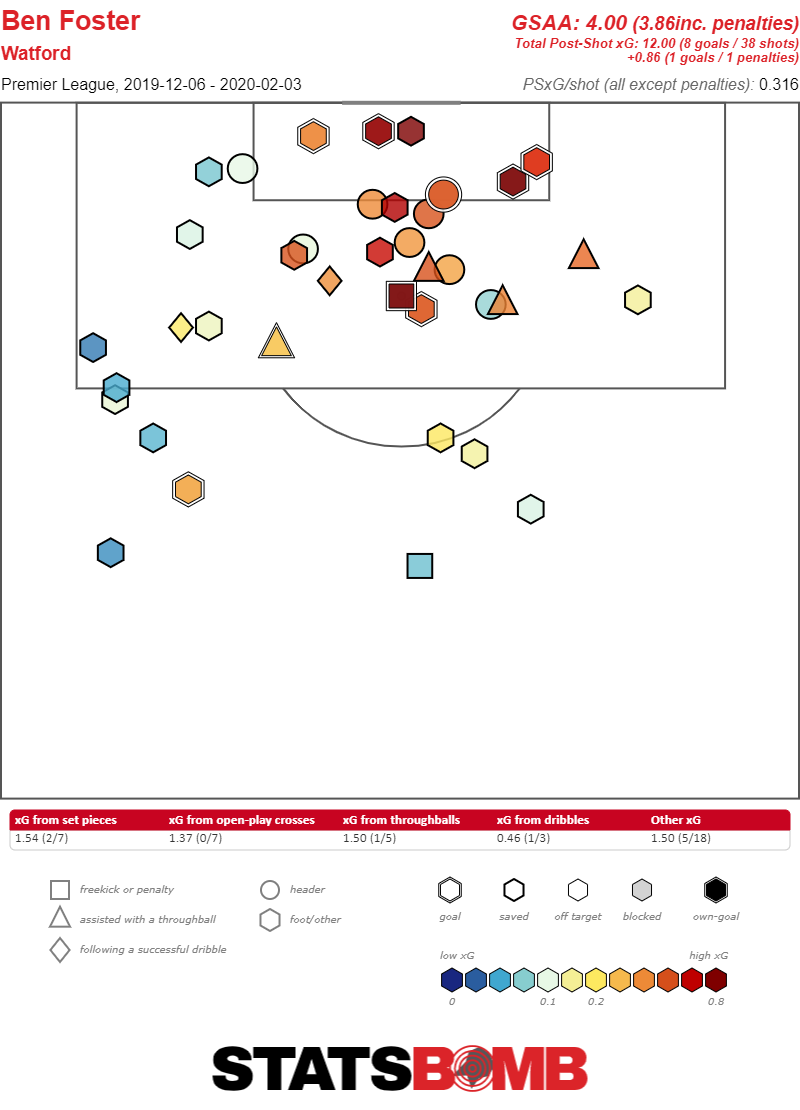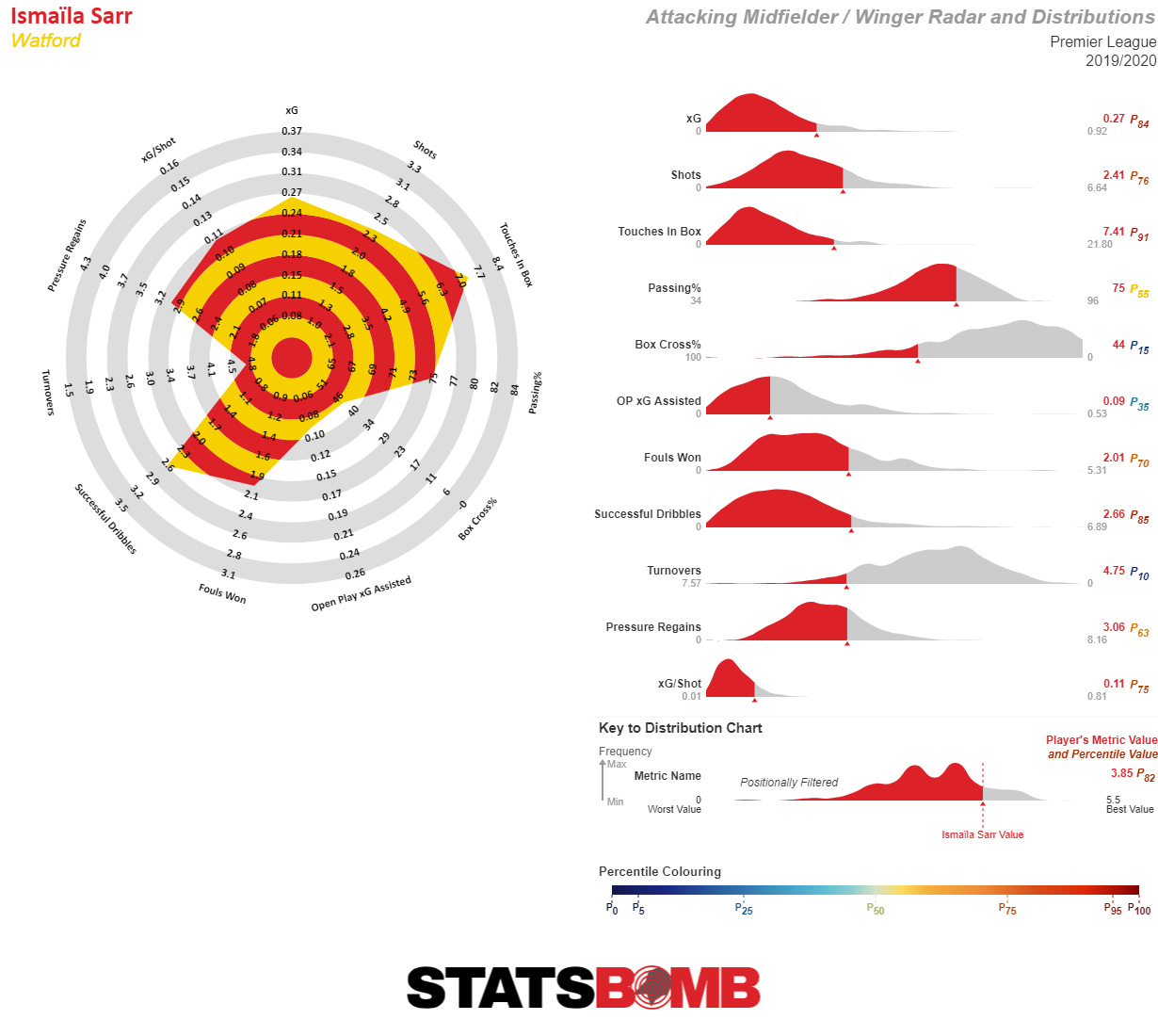The Hornets took an extremely dramatic path that left them now where they likely were always meant to be: a somewhat competent team that is neither a lock for relegation nor above the fray.
To recap: Watford fired manager Javi Gracia four matches into the season. His team had produced the third-most expected goals in the league and conceded the 14th-fewest expected goals, but disastrous finishing had left them with a solitary point. In came Quique Sánchez Flores, who got the team playing down to its place in the table. In addition to not finishing, the Hornets were no longer creating good chances; the defence stopped pressing and went from not good to league-worst. With the Hornets still rooted to the bottom of the table, Sánchez Flores was fired on December 6. In came Nigel Pearson of Leicester’s Great Escape fame. The Hornets promptly won a few games while a handful of bad teams stumbled. They entered February in the relegation zone on goal difference, just two points from 15th. After all that, survival is plausible.
This is largely a story about finishing luck. Prior to Pearson’s appointment, Watford had turned chances worth 15 expected goals into seven goals. Subsequently, they converted 10 expected goals into 11 goals. Reverting to normal finishing is a welcome improvement, but a team can’t dig itself out of a hole as deep as Watford’s with that alone; they need a period of luck to catch up. Indeed, Pearson’s opponents at Watford have converted 12.2 expected goals into just six goals. During that time, Ben Foster conceded 4 fewer goals than the average keeper when facing the same set of shots. Even for a good keeper, that’s a very hot streak.

Attributing Watford’s recovery to finishing luck doesn’t take anything away from Pearson. Managers of teams with finishing problems often flail about for a quick fix that only makes them worse. That’s how many teams spiral into relegation, and that's what was happening with Sánchez Flores. Competent finishing wouldn’t have saved his Watford side, which had an expected goal difference of -0.92 per match. The fact that they were also faced with hot finishing was just the cherry on top of a likely-to-be-relegated cake. It was entirely possible — if not likely — that Pearson would continue this downward spiral. Instead, he produced a functional team that takes decent shots and has a positive expected goal difference. Watford have been luckier under Pearson, but they’ve been able to turn that luck into a decent point haul because they aren’t fundamentally broken.
To fix the Hornets, Pearson has effectively split the difference between his predecessors’ styles. Watford allowed opponents to complete the fourth-fewest passes before performing a defensive action during Gracia’s season-opening stint and the fourth-most under Sánchez Flores. (Those four matches were extreme even for Gracia, but his team was consistently more aggressive than league average.) Pearson’s Watford is defending at a league-average distance from its goal and allowing a league-average number of passes before taking action. They pressure and recover the ball slightly more than league average. Basically, they pick their spots.
In attack, Pearson’s moved Abdoulaye Doucouré out of central midfield and into the hole behind fit-again striker Troy Deeney. In this 4-2-3-1ish formation, wingers Gerard Deulofeu and Ismaïla Sarr can run on to knockdowns from Deeney and get into the box. Indeed, getting into the box appears to be the new regime’s focus. While the Hornets are taking fewer shots than under Sánchez Flores, they’ve mostly eliminated long-range shots. Pearson’s Watford is also in the 93rd percentile when it comes to passes inside the box, behind only Manchester City, Chelsea and Liverpool. The shot quality makes up for the lost volume. Thus far, Watford have been a functioning attacking side under Pearson.

Can all of this continue? Setting aside Foster’s hot hand, Pearson’s Watford has the league’s 10th-best expected goal difference. Playing at this level should ensure survival. There is, of course, the possibility that Watford doesn’t keep this up; Pearson’s ten league matches form an encouraging-but-small sample. A slight drop in form would make for a tense spring while still probably being good enough for survival. It’s best not to think about what happens if Deeney gets injured again. It is more likely than not that Watford survives this season, a testament to Pearson’s turnaround, but the Hornets aren’t safe yet.
Even if Watford survives this season, it would be a mistake to think that this season is a blip and normal, mid-table service will continue going forward. With the exception of summer signing Ismaïla Sarr, this Watford squad is basically the same one Marco Silva had in 2017 — without Richarlison, its best player. Weighted by minutes played, Watford has an average age of 29.5 years, a figure that rivals the creaking mess better known as Crystal Palace.
On any given weekend, the majority of Watford’s players are wont to be on the wrong side of 30. Goalkeeper Ben Foster is 36, which is old even in goalkeeper years. The club remains dependent on striker Troy Deeney, who turns 32 this summer. (Insofar as Deeney’s injury absence might explain Sánchez Flores’ struggles, it’s an indictment of Watford’s squad construction.) Defenders aged 30, 33, and 35 have all already played more than 1,000 minutes this campaign. Craig Dawson, signed to shore up the defence in the summer, will turn 30 before the season’s up. Étienne Capoue, 31, has been on the pitch for every minute of this league campaign.
Watford’s squad doesn’t contain obvious solutions to their aging spine. Defenders Christian Kabasele and Kiko Femenia will be 29 when this campaign ends. Further up the pitch, the former prospects who never made it at other clubs repurposed by Silva and Gracia as complementary pressers attackers are at the end of their primes: Andre Gray is 28; Roberto Pereyra is 29; Tom Cleverley is 30. Younger contributors like Gerard Deulofeu (26) and Abdoulaye Doucouré (27) are at their peaks — both in terms of performance and sale value. As presently constituted, this Watford squad may survive the season but it’s only a matter of time before things fall apart.
The squad doesn’t have to be constituted like this forever, mind you. By all accounts, Watford are in better financial shape than Crystal Palace and could rejuvenate the side. Ismaïla Sarr, signed from Rennes in the summer, can be understood as the first step in such a process. The 21-year-old winger has done a good job of getting into the penalty box and taking decent shots. His lack of creative output when it comes to setting up other players hasn’t been a problem in Pearson’s system. Reportedly in the environs of £30 million, his signing fee was both a club record and the kind of modest risk a club like Watford should target while rebuilding.
At the start of the season, it was not immediately clear if Sarr was a one-off signing or the first part of a refreshed squad. Craig Dawson and Danny Welbeck, his fellow arrivals, suggested that the Pozzo family, despite their reputation for making lots of moves, might not be committed to rebuilding Watford. The winter transfer window, which saw Watford bring in 24-year-old winger Ignacio Pusetto from Udinese and 18-year-old Brazilian forward João Pedro, offers a bit more hope. Watford, these signings suggest, may not be mired in 2017 forever.
To belatedly rebuild the squad, however, Watford has to stay in the Premier League. Adequate Premier League sides that go down through a mix of bad finishing luck and a few months of silly management don’t always come right back up, further altering squad construction plans. This, one suspects, is why Sánchez Flores, the club’s second manager of the season, didn’t make it into December; it could have taken years to pull out of his continuing nosedive. A couple months later, the Watford rebuild seems much more plausible. But first, Pearson has to complete his second great escape.